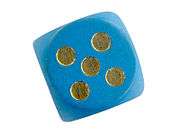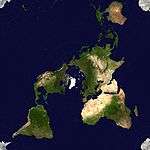Quincunx
A quincunx /ˈkwɪn.kʌŋks/ is a geometric pattern consisting of five points arranged in a cross, with four of them forming a square or rectangle and a fifth at its center.[1] It forms the arrangement of five units in the pattern corresponding to the five-spot on six-sided dice, playing cards, and dominoes. It is represented in Unicode as U+2059 ⁙ FIVE DOT PUNCTUATION or (for the die pattern) U+2684 ⚄ DIE FACE-5.

Historical origins of the name
The quincunx was originally a coin issued by the Roman Republic c. 211–200 BC, whose value was five twelfths (quinque and uncia) of an as, the Roman standard bronze coin. On the Roman quincunx coins, the value was sometimes indicated by a pattern of five dots or pellets. However, these dots were not always arranged in a quincunx pattern.
The Oxford English Dictionary (OED) dates the first appearances of the Latin word in English as 1545 and 1574 ("in the sense 'five-twelfths of a pound or as'"). The first citation for the geometric meaning, as "a pattern used for planting trees", dates from 1606. The OED also cites a 1647 reference to the German astronomer Kepler for an astronomical/astrological meaning, an angle of 5/12 of a whole circle. Jackson (1821) states that the word refers to the pattern of trees in an orchard, but then uses it more abstractly for a version of the orchard-planting problem involving patterns of points and lines in the plane (for which the quincunx pattern provides the optimal solution for five points).[2]
Examples
Quincunx patterns occur in many contexts:


- In heraldry, groups of five elements (charges) are often arranged in a quincunx pattern, called in saltire in heraldic terminology. The flag of the Solomon Islands features this pattern, with its five stars representing the five main island groups in the Solomon Islands. Another instance of this pattern occurred in the flag of the 19th-century Republic of Yucatán, where it signified the five departments into which the republic was divided.
- A quincunx is a standard pattern for planting an orchard.[3]
- Francis Galton's "quincunx" (referred to later as a "bean machine") is a physical demonstration of how the central limit theorem leads to a normal distribution; its pins are laid out in a quincunx pattern.
- Quincunxes are used in modern computer graphics as a pattern for multisample anti-aliasing. Quincunx antialiasing samples scenes at the corners and centers of each pixel. These five sample points, in the shape of a quincunx, are combined to produce each displayed pixel. However, samples at the corner points are shared with adjacent pixels, so the number of samples needed is only twice the number of displayed pixels.[4]
- In numerical analysis, the quincunx pattern describes the two-dimensional five-point stencil, a sampling pattern used to derive finite difference approximations to derivatives.[5]
- In architecture, a quincuncial plan, also defined as a "cross-in-square", is the plan of an edifice composed of nine bays. The central and the four angular ones are covered with domes or groin vaults so that the pattern of these domes forms a quincunx; the other four bays are surmounted by barrel vaults.[6] In Khmer architecture, the towers of a temple, such as Angkor Wat, are sometimes arranged in a quincunx to represent the five peaks of Mount Meru.[7]
- A quincunx is one of the quintessential designs of Cosmatesque inlay stonework.[8]
- A quincuncial map is a conformal map projection that maps the poles of the sphere to the centre and four corners of a square, thus forming a quincunx.
- The points on each face of a unit cell of a face-centred cubic lattice form a quincunx.
- The quincunx as a tattoo is known as the five dots tattoo. It has been variously interpreted as a fertility symbol,[9] a reminder of sayings on how to treat women or police,[10] a recognition symbol among the Romani people,[10] a group of close friends,[11] standing alone in the world,[12] or time spent in prison (with the outer four dots representing the prison walls and the inner dot representing the prisoner).[13] Thomas Edison, whose many inventions included an electric pen which later became the basis of a tattooing machine created by Samuel O'Reilly, had this pattern tattooed on his forearm.[14]
- The first two stages of the Saturn V super heavy-lift rocket had engines in a quincunx arrangement.[15]
- A baseball diamond forms a quincunx with the four bases and the pitcher's mound.[16]
- Early African American scientist Benjamin Banneker describes a dream in which he is asked to measure the shape of the soul after death. The answer is "quincunx". Research locates his ancestry in Senegal, where the quincunx is a common religious symbol.[17]
Literary symbolism
Various literary works use or refer to the quincunx pattern for its symbolic value:
- The English physician Sir Thomas Browne in his philosophical discourse The Garden of Cyrus (1658) elaborates upon evidence of the quincunx pattern in art, nature and mystically as evidence of "the wisdom of God". Although Browne wrote about quincunx in its geometric meaning, he may have been influenced by English astrology, as the astrological meaning of "quincunx" (unrelated to the pattern) was introduced by the astronomer Kepler in 1604.
- James Joyce uses the term in "Grace", a short story in Dubliners of 1914, to describe the seating arrangement of five men in a church service. Lobner[18] argues that in this context the pattern serves as a symbol both of the wounds of Christ and of the Greek cross.
- Lawrence Durrell's novel sequence The Avignon Quintet is arranged in the form of a quincunx, according to the author; the final novel in the sequence is called Quinx, the plot of which includes the discovery of a quincunx of stones.[19]
- The Quincunx is the title of a lengthy and elaborate novel by Charles Palliser set in 19th-century England, published in 1989; the pattern appears in the text as a heraldic device, and is also reflected in the structure of the book.[20]
- In the first chapter of The Rings of Saturn, W. G. Sebald's narrator cites Browne's writing on the quincunx. The quincunx in turn becomes a model for the way in which the rest of the novel unfolds.[21]
- Séamus Heaney describes Ireland's historical provinces as together forming a quincunx, as the Irish word for province cúige (literally: "fifth part") also explicates. The five provinces of Ireland were Ulster (north), Leinster (east), Connacht (west), Munster (south) and Meath (center, and now a county within Leinster). More specifically, in his essay Frontiers of Writing, Heaney creates an image of five towers forming a quincunx pattern within Ireland, one tower for each of the five provinces, each having literary significance.[22][23]
References
| Wikimedia Commons has media related to Quincunxes. |
| Look up quincunx in Wiktionary, the free dictionary. |
- Webster's Collegiate Dictionary, 10th ed., as quoted by Pajares-Ayuela (2001).
- Jackson, John (1821), "Trees planted in rows", Rational amusement for winter evenings, or, A collection of above 200 curious and interesting puzzles and paradoxes, pp. 33–34.
- Gourley, Joseph Harvey (2008), Modern Fruit Production, Read Books, pp. 106–107, ISBN 978-1-4437-2606-1.
- Chambers, Mike (February 27, 2001), "NVIDIA GeForce3 Preview", NV News, archived from the original on November 13, 2009.
- Knabner, Peter; Angermann, Lutz (2003), "1.2 The Finite Difference Method", Numerical Methods for Elliptic and Parabolic Partial Differential Equations, Texts in Applied Mathematics, 44, Springer-Verlag, pp. 21–29, ISBN 978-0-387-95449-3.
- R. Krautheimer, Early Christian and Byzantine Architecture, 1965
- Angkor Wat : Image of the Day
- Pajares-Ayuela, Paloma (2001), "The Signification — The Cosmatesque Quincunx: A Double-Cross Motif", Cosmatesque ornament: flat polychrome geometric patterns in architecture, W. W. Norton & Company, pp. 196–246, ISBN 978-0-393-73037-1.
- Gilbert, Steve (2000), Tattoo history: a source book : an anthology of historical records of tattooing throughout the world, Juno Books, p. 153, ISBN 978-1-890451-06-6.
- Turner, Robert (2005), Kishkindha, Osiris Press Ltd, p. 53, ISBN 978-1-905315-05-5.
- Daye, Douglas D. (1997), A law enforcement sourcebook of Asian crime and cultures: tactics and mindsets, CRC Press, p. 113, ISBN 978-0-8493-8116-4.
- Vigil, James Diego (2002), A rainbow of gangs: street cultures in the mega-city, University of Texas Press, p. 115, ISBN 978-0-292-78749-0.
- Baldayev, Danzig (2006), Russian criminal tattoo encyclopedia, Volume 3, FUEL Publishing, p. 214.
- Sherwood, Dane; Wood, Sandy; Kovalchik, Kara (2006), The Pocket Idiot's Guide to Not So Useless Facts, Penguin, p. 48, ISBN 978-1-59257-567-1.
- Allday, Jonathan (2000), Apollo in Perspective: Spaceflight Then and Now, CRC Press, p. 77, ISBN 9780750306454,
The engines were arranged across the base of the stage in the same pattern as the dots on a number 5 domino
. - di Milo, Brisbane (2002), "Telepathic letter to Alfred Jarry", in Clements, Cal (ed.), Pataphysica, Writers Club Press, pp. 60–68, ISBN 9780595236046. See in particular p. 62.
- Eglash, Ron (April 1997), "The African heritage of Benjamin Banneker", Social Studies of Science, 27 (2): 307–315, JSTOR 285472
- Lobner, Corinna del Greco (1989), "Equivocation As Stylistic Device: Joyce's 'Grace' and Dante", Lectura Dantis, 4; for additional work on this instance of the quincunx pattern, see Duffy, Charles F. (1972), "The Seating Arrangement in 'Grace'", James Joyce Quarterly, 9: 487–489.
- Gifford, James (1999), "Reading Orientalism and the Crisis of Epistemology in the Novels of Lawrence Durrell", CLCWeb: Comparative Literature and Culture, 1 (2),
the most dominant formal element expressing this state of multiplicity in The Avignon Quintet is its quincunx structure
. - Onega, Susana (2000), "Mirror games and hidden narratives in The Quincunx", in Todd, Richard; Flora, Luisa (eds.), Theme Parks, Rainforests and Sprouting Wastelands: European Essays on Theory and Performance in Contemporary British Fiction, Costerus New Series, 123, Rodopi, pp. 151–163, ISBN 9789042005020.
- Horstkotte, Silke (2005), "The double dynamics of focalization in W. G. Sebald's The Rings of Saturn", in Meister, Jan Christoph (ed.), Narratology Beyond Literary Criticism: Mediality, Disciplinarity, Narratologia : contributions to narrative theory, 6, Walter de Gruyter, pp. 25–44, ISBN 9783110183528.
- Heaney, Séamus (1995), "Frontiers of Writing", The Redress of Poetry: Oxford Lectures, Faber and Faber, pp. 186–202.
- Corcoran, Neil (1999), Poets of Modern Ireland, SIU Press, p. 62, ISBN 9780809322909.

